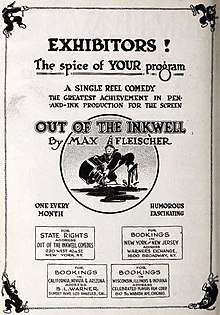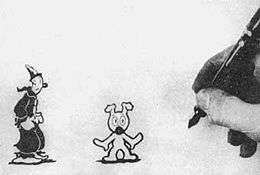Out of the Inkwell
Out of the Inkwell was a major animated series of the silent era produced by Max Fleischer from 1918 to 1929.[1]
| Out of the Inkwell | |
|---|---|
 Advertisement | |
| Directed by | Max Fleischer Dave Fleischer |
| Produced by | Max Fleischer |
| Written by | Max Fleischer |
Release date | 1918–1929 |
| Country | United States |
| Language | Silent film |

History
The series was the result of three short experimental films that Max Fleischer independently produced from 1914 to 1916 to demonstrate his invention, the rotoscope, a device consisting of a film projector and easel used to achieve realistic movement for animated cartoons. The rotoscope projected motion picture film through an opening in the easel, covered by a glass pane serving as a drawing surface. The image on the projected film was traced onto paper, advancing the film one frame at a time as each drawing was made. Fleischer's younger brother Dave Fleischer, who was working as a clown at Coney Island, served as the model for their first famous character, eventually known as Koko the Clown.
Out of the Inkwell began at the Bray Studio as a monthly entry in The Bray Pictograph Screen Magazine produced for Paramount from 1918, and later for Goldwyn from 1920 to 1921. In that same year, The Fleischer brothers started their own studio, and in 1923, the clown who previously had no name came to be known as Koko when animation veteran Dick Huemer became the new director of animation.
Huemer, who began his animation career with the Mutt and Jeff cartoons in 1916, brought the influence of the short and tall companions to Out of the Inkwell with the creation of a small canine companion named Fitz, who later evolved into Bimbo in the sound era. Huemer redesigned the clown for animation, which reduced the Fleischer's dependency on the Rotoscope for fluid animation. He also defined the drawing style with his distinctive inking quality that the series was famous for. But it was the interaction of the live action sequences with the artist/creator, Max Fleischer and his pen and ink creations that was the foundation of the series. Typically, the cartoons start out with live action showing Max drawing the characters on paper, or opening the inkwell to release the characters into "reality."
The Out of the Inkwell series ran from 1918 to mid 1927,[2] and was renamed The Inkwell Imps for Paramount, continuing until 1929.[3] In all, 62 Out of the Inkwell and 56 Inkwell Imps films were produced in eleven years. The Inkwell Imps series was replaced by the "Talkartoons" in 1929, and Koko was retired until 1931, appearing as a supporting character with Bimbo and Betty Boop. Koko's last theatrical appearance was in the Betty Boop cartoon Ha-Ha-Ha (1934), a remake of the silent Out of the Inkwell film The Cure (1924). Koko had a brief cameo in his only color theatrical appearance in the Screen Song entry Toys will be Toys (1949).
In 1950, Stuart Productions released a number of the Inkwell Studios Out of the Inkwell cartoons, and a selection of the Paramount Inkwell Imps cartoons to television.[4] In 1955, the Inkwell Imps, along with 2,500 pre-October 1950 Paramount shorts and cartoons were sold to television packagers, the majority acquired by U.M. & M. TV Corporation.
In 1958, Max Fleischer revived his studio in a partnership with Hal Seeger, and in 1960 produced a series of one hundred Out Of The Inkwell five-minute cartoons. In the new color series, Koko had a clown girlfriend named Kokette, a pal named Kokonut and a villain named Mean Moe. Larry Storch provided the voice for Koko and all of the supporting characters. Many of the shorts in the original series are now in the public domain. One short in the series, 1922's The Hypnotist, was preserved by the Academy Film Archive in 2010.[5]
Filmography
The Bray Studio Years (1918–1921)
- Experiment No. 1 (1918)
- Experiment No. 2 (1919)
- Experiment No. 3 (1919)
- Experiment No. 4 (1919)
- The Clown's Pup (1919)
- The Tantalizing Fly (1919)
- Slides (1919)
- The Boxing Kangaroo (1920)
- Chinamen (1920)
- The Circus (1920)
- The Ouija Board (1920)
- The Clown's Little Brother (1920)
- Poker (1920)
- Perpetual Motion (1920)
- The Restaurant (1920)
- Cartoonland (1921)
- The Automobile Ride (1921)
Inkwell Studio: Out of The Inkwell years 1921–1926
- Modeling (1921)
- Fishing (1921)
- Invisible Ink (1921)
- The Fish (1922)
- The Mechanical Doll (1922)
- The Mosquito (1922)
- Bubbles (1922)
- Flies (1922)
- Pay Day (1922)
- The Hypnotist (1922)
- The Challenge (1922)
- The Show (1922)
- The Reunion (1922)
- The Birthday (1922)
- Jumping Beans (1922)
- Surprise (1923)
- The Puzzle (1923)
- Trapped (1923)
- The Battle (1923)
- False Alarm (1923)
- Balloons (1923)
- The Fortune Teller (1923)
- Shadows (1923)
- Bed Time (1923)
- The Laundry (1924)
- Masquerade (1924)
- The Cartoon Factory (1924)
- Mother Gooseland (1924)
- A Trip To Mars (1924)
- A Stitch in Time (1924)
- Clay Town (1924)
- The Runaway (1924)
- Vacation (1924)
- Vaudeville (1924)
- League of Nations (1924)
- Sparring Partners (1924)
- The Cure (1924)
- Koko the Hot Shot (1925)
- Koko the Barber (1925)
- Big Chief Koko (1925)
- The Storm (1925)
- Koko Trains 'Em (1925)
- Koko Sees Spooks (1925)
- Koko Celebrates the Fourth (1925)
- Koko Nuts (1925)
- Koko on the Run (1925)
- Koko Packs 'Em (1925)
- Koko Eats (1925)
- Thanksgiving (1925)
- Koko Steps Out (1925)
- Koko in Toyland (1925)
- My Bonnie September (1925)
- Koko's Paradise (1926)
- Koko Baffles the Bulls (1926)
- It's the Cats (1926)
- Koko at the Circus (1926)
- Toot Toot (1926)
- Koko Hot After It (1926)
- Fadeaway (1926)
- Koko's Queen (1926)
- Koko Kidnapped (1926)
- Koko the Convict (1926)
- Koko Gets Egg-Cited (1926)
Inkwell Imps (1927–1929)
- Koko Back Tracks (1927)
- Koko Makes 'Em Laugh (1927)
- Koko in 1999 (1927)
- Koko the Kavalier (1927)
- Koko Needles the Boss (1927)
- Ko-Ko Plays Pool (1927)
- Ko-Ko's Kane (1927)
- Ko-Ko the Knight (1927)
- Ko-Ko Hops Off (1927)
- Ko-Ko the Kop (1927)
- Ko-Ko Explores (1927)
- Ko-Ko Chops Suey (1927)
- Ko-Ko's Klock (1927)
- Ko-Ko's Quest (1927)
- Ko-Ko the Kid (1927)
- Ko-Ko's Kink (1928)
- Ko-Ko's Kozy Korner (1928)
- Ko-Ko's Germ Jam (1928)
- Ko-Ko's Bawth (1928)
- Ko-Ko Smokes (1928)
- Ko-Ko's Tattoo (1928)
- Ko-Ko's Earth Control (1928)
- Ko-Ko's Hot Dog (1928)
- Ko-Ko's Haunted House (1928)
- Ko-Ko's Lamp Aladdin (1928)
- Ko-Ko Squeals (1928)
- Ko-Ko's Field Daze (1928)
- Ko-Ko Goes Over (1928)
- Ko-Ko's Catch (1928)
- Ko-Ko's War Dogs (1928)
- Ko-Ko's Chase (1928)
- Ko-Ko Heaves Ho (1928)
- Ko-Ko's Big Pull (1928)
- Ko-Ko Cleans Up (1928)
- Ko-Ko's Parade (1928)
- Ko-Ko's Dog Gone (1928)
- Ko-Ko in the Rough (1928)
- Ko-Ko's Magic (1928)
- Ko-Ko on the Track (1928)
- Ko-Ko's Act (1928)
- Ko-Ko's Courtship (1928)
- No Eyes Today (1929)
- Noise Annoys Ko-Ko (1929)
- Ko-Ko Beats Time (1929)
- Ko-Ko's Reward (1929)
- Ko-Ko's Hot Ink (1929)
- Ko-Ko's Crib (1929)
- Ko-Ko's Saxophonies (1929)
- Ko-Ko's Knock Down (1929)
- Ko-Ko's Signals (1929)
- Ko-Ko's Conquest (1929)
- Ko-Ko's Focus (1929)
- Ko-Ko's Harem Scarum (1929)
- Ko-Ko's Big Sale (1929)
- Ko-Ko's Hypnotism (1929)
- Chemical Ko-Ko (1929)
References
- Maltin, Leonard (1987). Of Mice and Magic: A History of American Animated Cartoons (Revised ed.). Plume Books. pp. 85–89. ISBN 0-452-25993-2.
- Lenburg, Jeff (1999). The Encyclopedia of Animated Cartoons. Checkmark Books. pp. 40-42. ISBN 0-8160-3831-7. Retrieved 6 June 2020.
- Lenburg, Jeff (1999). The Encyclopedia of Animated Cartoons. Checkmark Books. pp. 31-32. ISBN 0-8160-3831-7. Retrieved 6 June 2020.
- Woolery, George W. (1983). Children's Television: The First Thirty-Five Years, 1946-1981, Part 1: Animated Cartoon Series. Scarecrow Press. pp. 209-210. ISBN 0-8108-1557-5. Retrieved 14 March 2020.
- "Preserved Projects". Academy Film Archive.
External links


- Max Fleischer's Famous Out of the Inkwell, Inkwell Images